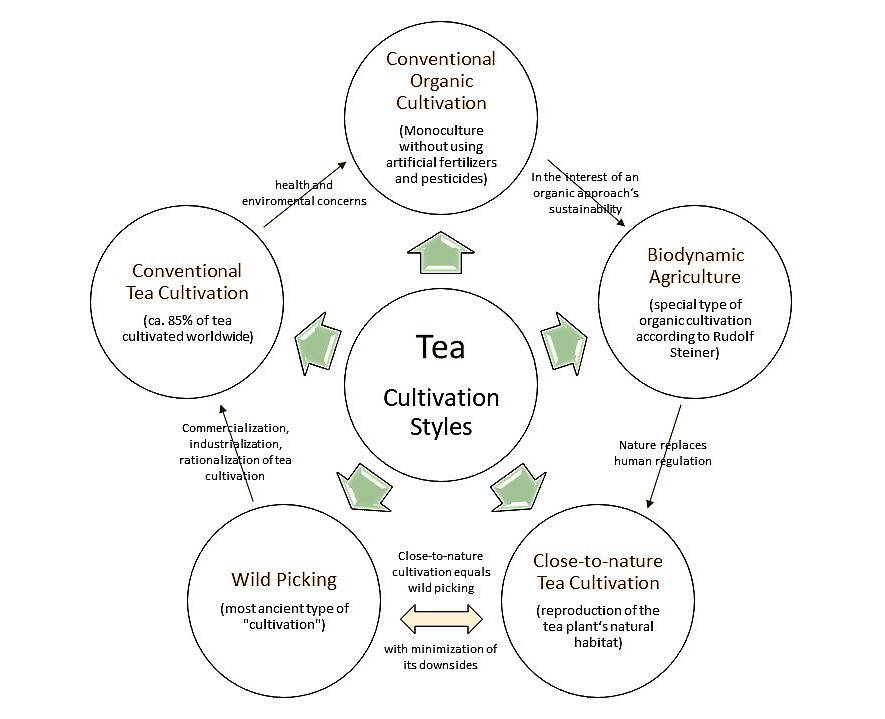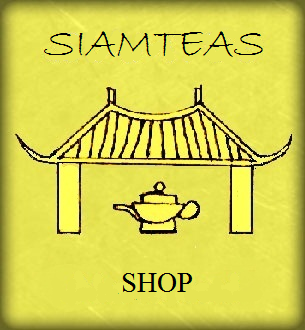Tea Cultivation : Classification of Cultivation Styles
There are 5 basic styles of tea cultivation:
- Wild Picking
- Conventional Tea Cultivation
- Conventional Organic Cultivation
- Biodynamic Cultivation
- Close-to-nature Cultivation (biodiverse)
The underlying distinction lies in the way in which cultivation interacts with nature.

1. Wild Picking
Picking leaves from wild tea trees in the forest is the most ancient form of of tea cultivation. Of course, this actually isn’t cultivation at all, as wild tea trees are not cultivated. However, as soon as leaves are picked, a certain degree of cultivation inevitably comes into play. For on the one hand, plucking alone already constitutes an intervention in nature. And on the other hand, regular picking is usually accompanied by further cultivation measures. An example of this would be the regular pruning of branches in favor of increased budding.
In fact, tea from wild tea trees does not exist at all, because the tea tree is no longer really wild the moment its leaves float in your teapot. So the so-called wild picking actually rather corresponds to a “cultivation of tea plants in their natural environment”.
The advantages and disadvantages are obvious. On the one hand, you get the most authentic tea. That is, the unadulterated result of the natural interplay of terroir and variety (see lesson 5). And second, of course, this is the most environment-friendly form of tea cultivation. Furthermore, tea from wild picking is considered to be particularly rich in ingredients as well as being particularly complex in terms of their composition.
The down side, on the other hand, is the relatively low yield with comparably high outlay and the approach’s resulting limited profitability. This is, because wild-growing tea trees are difficult to access. In addition, they often require climbing for picking. And finally, the freshly picked tea leaves mostly have to travel a long way on arduous paths to the tea factory.
2. Conventional Tea Cultivation – Monoculture
The so-called “conventional” tea cultivation is the result of the elimination of the above-mentioned downsides of wild picking in the course of the industrialization of tea cultivation. That is, in order to maximize yield, as many tea plants as possible cover a given area. These are nicely set in rows in favor of easy access. Then, regular pruning further increases picking friendliness and yield. Since other plants, ie trees, shrubs, grasses, etc., have to give way to this strategy, the result is a monoculture.
In order to ensure the necessary input into the soil, monoculture can’t do without the use of fertilizers. In addition, the concentrated cultivation of a single plant inevitably attracts its predators, or deprives the same of natural alternatives. Then, to combat such “pests”, the use of pesticides (insecticides, herbicides, fungicide) comes into play. In the process, residues of these substances, which are toxic for humans, too, remain at the leave. As a result, what may make sense commercially and in view of a 5 billion strong world population’s demand for the world’s most drunk beverage other than water does not appear to be the ideal solution. Therefore, health and environmental concerns in the 20th century have led to the development of alternative approaches. These take commercial profitability, quality requirements, environmental and health aspects into account at different weighting.
3. Conventional Organic Cultivation
Conventional organic cultivation puts the factor “health” in the foreground. In its most naive form, it continues monoculture, but refrains from using harmful substances such as artificial fertilizers and pesticides. The consequences are extreme low yields and a tendency to inferior tea with increasing depletion of the soil. In order to still achieve profitability, such tea is also significantly more expensive than tea from conventional cultivation. In order to address these issues, conventional organic tea growing projects will mostly show elements of the biodynamic cultivation style.
4. Biodynamic Tea Cultivation
Biodynamic agriculture is a special form of organic farming. It is a system combining crop growing, livestock farming, seed production and landscape management, introduced by Rudolf Steiner. In a lecture series in 1924, the founder of anthroposophy presented a new holistic concept of agriculture, intended to counteract the anticipated degeneration of product and seed in conventional cultivation. For example, the closed biodynamic system produces its own natural fertilizers, and pest populations are managed in a natural way.
The esoteric elements in Steiner’s anthroposophical approach have earned the same much scepticism ever since. Nevertheless, in 1924 the concept was was ahead of its time. In fact, it was the first concept of organic agriculture at all. However, a clear disadvantage of the concept is the high share of human intervention (planning, organization, implementation, follow-up and regulation, etc.). That is, the method creates an alternative, man-managed ecosystem parallel to that of nature. Another downside is the expense associated with creating and maintaining this system, resulting in particularly high product prices.
For tea cultivation, a biodynamic approach in practice also means that a venture cannot restrict on tea cultivation alone. This is, because the system also requires elements of livestock farming and landscape management. Nevertheless, the approach is still in practice today. A well-known example of this is the (Demeter-certified) Makaibari Tea Estate in Darjeeling.
5. Close-to-nature Tea Cultivation (biodiverse)
The most modern approaches in tea cultivation rely on nature itself for regulating the soil and controlling pest populations. For this purpose, natural, biodiverse ecosystems are virtually reconstructed or remodeled. This way, a circle closes, as the approach has much in common with the most original form of tea cultivation, wild picking. At the same time, close-to-nature cultivation reduces the downsides of collecting tea leaves in the wild to a minimum.
The cultivation of tea bushes in biodiverse areas, which are similar to those of the natural habitat of the bushes, was long dismissed by the agricultural industry with reference to the expected low yield. However, today relevant projects in Japan, China, India, and elsewhere show that such tea gardens can score good yields and be profitable. Admittedly, the creation of suitable acreages is time-consuming and labor-intensive. However, once the system has been established, it maintains and regulates itself with little intervention.
The boldest argument against this approach is an assumed mismatch between the availability of suitable acreage and the mass demand for tea on the world market. The question is, if and to what extent this approach can meet the demand of more than 5 billion people. Respectively, which other – social, economic and political – parameters would need change to make this possible.
The Tea in Your Cup…
So, why is the style of cultivation relevant for the tea in your cup? Well, an estimated 85% of the world’s tea falls into the category of conventional cultivation. Hence, the probability that your tea comes from monoculture using artificial fertilizers and pesticides is 85%! Plus, the remaining 15% still offer a fairly wide quality range. It therefore makes sense for you to know which type of cultivation is attributable to your tea.
One more thing, on my own account…
Like this article? To support the maintenance and further development of My Little Tea School – the ABC of Tea, shop for tea at
- Authentique single origin teas from all over the world
- Finest quality handpicked artisan and specialty teas
- Great choice of wild and close-to-nature cultivated teas
- Informative product pages and blog articles
- Rich illustration and instruction
- Unparelleled service level

